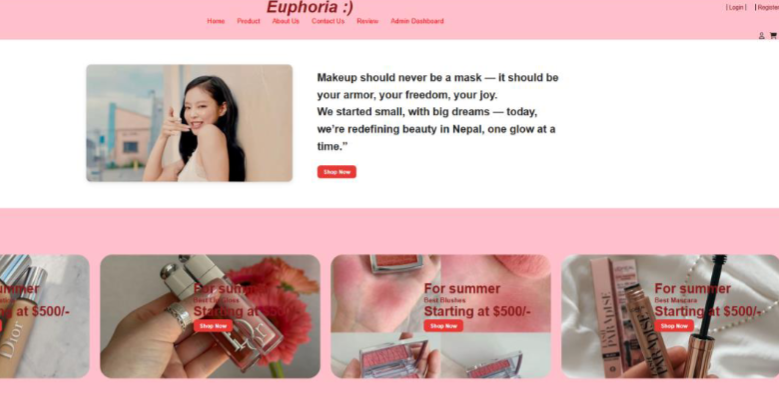Case Study: Euphoria Makeup E-commerce Website (Java)
1. Project Overview
Project Name: Euphoria Makeup E-commerce Website
Type: Java-based e-commerce application
Technologies Used: Java (Servlets & JSP, JDBC), HTML/CSS, MySQL
Developer: Shreya Shrestha
Purpose: Build a functional e-commerce platform for makeup products using Java while applying OOP and clean UI fundamentals.
Project Goals
- Showcase products with descriptions and pricing
- Allow browsing, registration, login, and cart management
- Demonstrate Java, OOP, and database skills
- Maintain a user-friendly, interactive interface
2. Problem Statement
Many small e-commerce platforms in Nepal suffer from poor usability and outdated back-end handling. This project focuses on a simple, structured, and functional experience where users can browse products, make selections, and manage their shopping journey—while showcasing Java web application skills.
3. Target Audience
- Makeup enthusiasts shopping online
- Users who value a simple, interactive UI backed by Java OOP and database operations
- Desktop users accessing via a web browser
4. Research & Inspiration
- Competitor Analysis: Sephora, Nykaa
- UI/UX Patterns: Clear categories, easy navigation, clean layout
- Technology Research: JSP/Servlet session management, JDBC for data, HTML/CSS for presentation
5. Methodology
Approach: Prototype Methodology
- Requirement Gathering: pages, features, database tables
- Prototype Development: JSP pages for Home, Product, Login, Cart
- Iterative Refinement:
- Add JDBC database connectivity
- Implement registration/login, cart management, order simulation
- Add product filtering and reviews
- Testing: sessions, queries, front-end display
Why Prototype? Enables quick working versions, feedback loops, and iterative improvements—ideal for tight timelines and academic submissions.
6. Features
| Feature | Implementation |
|---|---|
| Home Page | Displays featured products dynamically from Java backend |
| Product Page | Details, pricing, and “Add to Cart” |
| User Authentication | Servlet/JSP forms for Login & Registration |
| Shopping Cart | Java objects with HttpSession tracking |
| Order Simulation | Tracks items and calculates totals |
| Reviews | JDBC data retrieval and display |
| Database Connectivity | JDBC to MySQL (or H2) for products/users/cart |
| Responsive Design | Basic HTML/CSS for layout consistency |
7. Challenges & Solutions
| Challenge | Solution |
|---|---|
| Integrating Servlets with front-end | MVC separation: Servlets for logic, JSP for view |
| User sessions and cart data | HttpSession-based cart state |
| Database connectivity & queries | JDBC with prepared statements |
| UI/UX in Java web context | JSP + CSS for clean layout and navigation |
8. Screenshots / Dashboard Images
Include screenshots of JSP pages, product listing, shopping cart, login page, and reviews here.

9. Outcome & Impact
- Functional Java-based e-commerce application
- Demonstrates OOP, Servlets, JSP, JDBC
- Clean and interactive interface for browsing and simulated purchases
- Strong portfolio addition for internships/academics
10. Tools & Technologies
- Java; JSP & Servlets; JDBC
- MySQL / H2 for data storage
- VS Code / Eclipse / NetBeans
- Browser DevTools
11. Lessons Learned
- OOP for managing products, users, orders
- Session management and data persistence
- MVC separation improves maintainability
- Planning, prototyping, and iteration improve quality
12. References
- Oracle Java Tutorials – Servlets & JSP
- W3Schools – JDBC, JSP, Servlet examples
- YouTube – Java web projects / e-commerce tutorials
- Competitors – Sephora, Nykaa